April 2023
- English
- 日本語
The Tea Ceremony Tradition Passed Down in Hiroshima

Ueda Sokei, 16th generation grandmaster of the Ueda Soko Ryu school of tea ceremony 
Ueda Sokei (center) drinking tea in a room at Wafudo
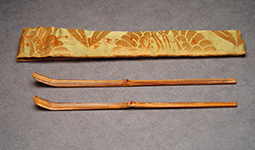
Tea scoops called Tekigakure (“hiding from the enemy”) by Ueda Soko (top, 19 cm; bottom, 18.3 cm) 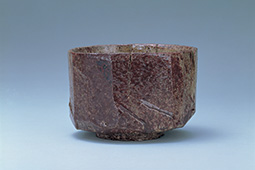
The tea bowl Satemo by Ueda Soko (8.2 cm x 12.4 cm) 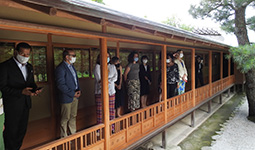
Ambassadors to Japan view the garden at Wafudo, August 6, 2022 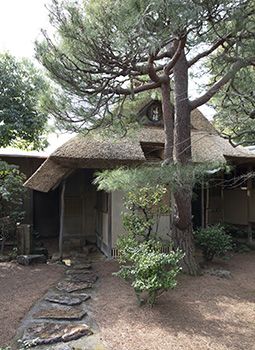
The tea pavilion Ensho at Wafudo 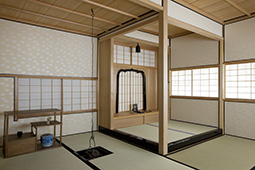
The team room Kusari-no-ma at Wafudo 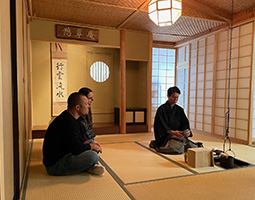
A teacher (right) of the Ueda Soko Ryu school entertains guests at a tea room in New York

We spoke with Ueda Sokei, 16th generation grandmaster of the Ueda Soko Ryu school of tea ceremony, about the tea ceremony tradition that has been passed down for over 400 years in Hiroshima.

Please tell us about sado (also known as chanoyu or chado), the Japanese tradition of tea ceremony.
The philosophy and forms of sado, which have been handed down to the present day, developed between the middle of the 15th century and the start of the 17th century when there were many battles between daimyo (feudal lords) across Japan. Put simply, sado is the act of serving tea and entertaining in front of guests invited by the host, but it is also a form of traditional Japanese comprehensive culture that includes a variety of elements, including the motions when serving tea, the tea bowls, the flowers and hanging scrolls decorating the tea room, the tea room itself, the garden, and more.
Sado stimulates the five human senses. Sitting in a quiet tea room, you become highly sensitive to the sound of the water boiling, the aroma of the incense, the feel of the tea bowl, the taste of the tea, and more. In doing so, your mind naturally relaxes, and you forget the many happenings of your everyday life. You enter into a mood that feels as if your body and mind are purified. These sensations gained through sado are the same for people today as they were for warriors during times of war.
Please tell us about the Ueda Soko Ryu school of tea ceremony that was founded in Hiroshima.
There are a number of schools of sado. The Ueda Soko Ryu school was founded by Ueda Soko (1563–1650), who was renowned as a brave and intrepid warrior and with many military exploits. In 1619, Soko served under the feudal lord of the Hiroshima Domain and governed the western part of the present-day Hiroshima Prefecture.
Soko first studied tea ceremony under Sen no Rikyu (1522–1591), the man who perfected sado. He later studied under Furuta Oribe (1544–1615), a student of Sen no Rikyu and regarded as the best tea master at that time, and together they established buke sado, or warrior tea. They may have been strongly attracted to sado, which offers calmness of the mind, as they both lived alongside death as warriors.
Soko has left behind sado utensils. Two tea scoops known as Tekigakure (meaning “hiding from the enemy”) are utensils he is said to have made calmly with a small knife, with bamboo he cut from a bamboo grove while waiting as the enemy pressed upon him. They are such beautiful objects that it is hard to believe they were made in the middle of a battle. A tea bowl known as Satemo is another of the fine tea items made by Soko. With this tea bowl, you can sense strength from the herame pattern on the surface made with a spatula, while at the same time, you can feel the warmth of Soko’s hands. Soko was also known as a garden designer and he designed Shukkeien Garden (see here) in Hiroshima, as well as Omotegoten Garden of Tokushima Castle, Nishinomaru Garden of Wakayama Castle and Ninomaru Garden of Nagoya Castle. In this way, we can say that Soko was both a warrior and an artist.


I am now the 16th generation grandmaster after Soko. Following Soko, the Ueda family served the feudal lord of the Hiroshima Domain as chief retainers and governed western Hiroshima during the Edo period lasting for about 260 years from the beginning of the 17th century. That was why the Ueda family gave the responsibility to pass on and teach Soko’s sado to retainers called “chaji-azukari.” However, since 1955, the head of the Ueda family himself has directly passed on and taught Soko’s sado as head of the school. Currently, we offer lessons in Hiroshima, Kyoto, Osaka, and Tokyo, as well as abroad in Germany, France, the United Kingdom, Australia, the United States, Brazil, and more.
What kind of people study sado of the Ueda Soko Ryu school overseas?
A variety of people practice, including designers, architects, artists and teachers. People today, both Japanese and otherwise, typically work, eat and drink while sitting in a chair. Even in sado, there are now times when we sit in chairs as the host serves tea and the guests drink. But the traditional tea ceremony is performed in a tea room while sitting seiza-style (kneeling) or cross-legged on tatami mats. People from outside Japan may experience a completely new kind of stimulation sitting while quietly drinking tea in a tea room, a space that is vastly different from the places they spend their everyday lives.
Actually, on August 6 each year, ambassadors to Japan from countries around the world attend a peace memorial ceremony held at the Peace Memorial Park, and they also visit the Ueda Soko Ryu school’s Wafudo villa, located here in Furuehigashi-machi in western Hiroshima City. The mayor of Hiroshima invites the ambassadors as part of a program to experience the culture of Hiroshima. Around 40 ambassadors and their families have attended almost every year for the last 20 years or so. Each time, I explain sado and the Ueda Soko Ryu school to our guests and serve them tea. When everyone leaves, they have very cheerful expressions on their faces, perhaps because they feel refreshed.

Please tell us about the history of Wafudo.

Wafudo was rebuilt through the support of many of those with a desire to preserve the tradition and culture that have been passed down in Hiroshima for around 400 years. Completed in 2008 after more than 30 years of work, Wafudo is a roughly 5,200 square meter replica of the Ueda family residence that Soko himself built within the grounds of Hiroshima Castle. When the atomic bomb was dropped, the Ueda family was living in this region away from the city center, and so none of the art works or ancient documents passed down since the time of Soko were damaged. Illustrations of the residence were also left behind, so it was possible to build a replica.
Wafudo’s outstanding feature is the integration of a building called a charyo, which features a tea room, with the typical Shoin-style warrior residence. This type of building was built for vassals to serve tea to visiting lords in the sukiya-onari, a ceremony that began in the early 17th century. “Sukiya” refers to the charyo and “onari” refers to the lords visiting the vassal’s home.

Wafudo is the only building remaining of its kind in Japan, and it is visited by a variety of people from Hiroshima Prefecture and all over Japan. For example, a designer for Mazda, a car manufacturer headquartered in Hiroshima, said that he got the inspiration for a car design from Wafudo. According to him, when he entered the tea room at Wafudo and heard the dry sound of the door at the entryway closing, he felt as if he had entered another world. He said that he designed the doors of a car he worked on (a two-seater sports car released in 1989) to make a sound when closing them such that you feel you are entering another world.

The eyes of the world will be on Hiroshima as it hosts the G7 Hiroshima Summit in May. Can you recommend some places for people visiting Hiroshima from abroad?
No matter when I go, I always think Itsukushima Shrine (see here) is fantastic. The scene of islands floating in the Seto Inland Sea is also truly beautiful every time I see it. I would also suggest visitors from overseas see a game at the stadium featuring the professional baseball team, the Hiroshima Toyo Carp. This team is like family to the people of Hiroshima. Visitors can experience a unique atmosphere at the stadium created by the enthusiastic support of the fans.
More than anything else, I hope visitors can see the beautiful city of Hiroshima. I was born just before the atomic bomb was dropped on Hiroshima, so I was raised amidst the rebirth of Hiroshima from the ruins. The people of Hiroshima poured out enormous energy and rebuilt the city and their own lives. As a result, Hiroshima became a beautiful city. Yet, I hope visitors will also learn that this came at the expense of a great many lives.

